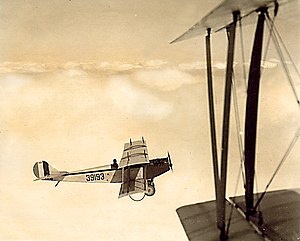
The Fokker Scourge occurred during the First World War from July 1915 to early 1916. Imperial German Flying Corps units, equipped with Fokker Eindecker fighters, gained an advantage over the Royal Flying Corps (RFC) and the French Aéronautique Militaire.
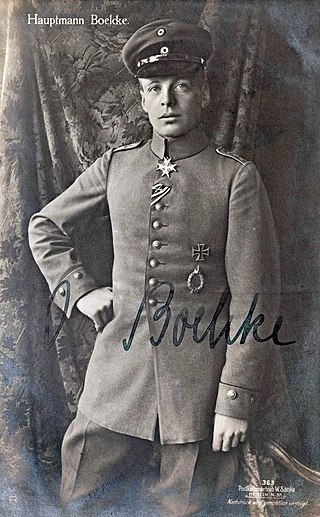
Oswald Boelcke PlM was a World War I German professional soldier and pioneering flying ace credited with 40 aerial victories. Boelcke is honored as the father of the German fighter air force, and of air combat as a whole. He was a highly influential mentor, patrol leader, and tactician in the first years of air combat, 1915 and 1916.
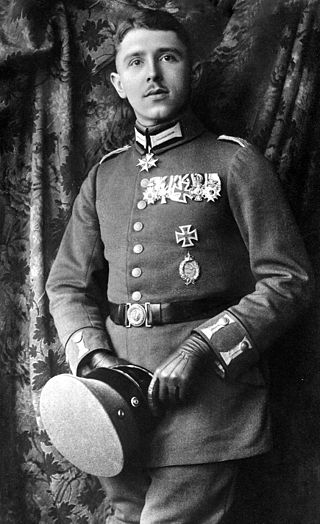
Max ImmelmannPLM was the first German World War I flying ace. He was a pioneer in fighter aviation and is often mistakenly credited with the first aerial victory using a synchronized gun, which was in fact achieved on 1 July 1915 by the German ace Kurt Wintgens. He was the first aviator to receive the Pour le Mérite, being awarded it at the same time as Oswald Boelcke. His name has become attached to a common flying tactic, the Immelmann turn, and remains a byword in aviation. He is credited with 15 aerial victories.

The Thach weave is an aerial combat tactic that was developed by naval aviator John S. Thach and named by James H. Flatley of the United States Navy soon after the United States' entry into World War II.
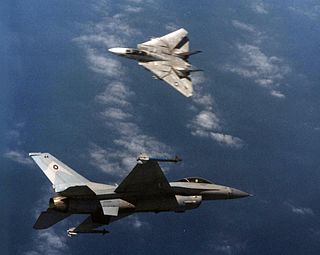
A dogfight, or dog fight, is an aerial battle between fighter aircraft conducted at close range. Modern terminology for air-to-air combat is air combat manoeuvring (ACM), which refers to tactical situations requiring the use of individual basic fighter maneuvers (BFM) to attack or evade one or more opponents. This differs from aerial warfare, which deals with the strategy involved in planning and executing various missions.

The Dicta Boelcke is a list of fundamental aerial maneuvers of aerial combat formulated by First World War German flying ace Oswald Boelcke. Equipped with one of the first fighter aircraft, Boelcke became Germany's foremost flying ace during 1915 and 1916. Because of his success in aerial combat and analytic mind, he was tasked by Colonel Hermann von der Lieth-Thomsen with writing a pamphlet on aerial tactics. Completed in June 1916, it was distributed throughout the German Army's Air Service (Die Fliegertruppen des Deutschen Reiches), some two years before the French and British militaries followed suit with their own tactical guides. Air combat tactical manuals based on the Dicta Boelcke have become more elaborate over time, and have become a mainstay for NATO's air combat training of American, German, Dutch, Norwegian, Turkish, Italian, and Greek fighter pilots.

Air combat manoeuvring is the tactical art of moving, turning and/or situating one's fighter aircraft in order to attain a position from which an attack can be made on another aircraft. Air combat manoeuvres rely on offensive and defensive basic fighter manoeuvring (BFM) to gain an advantage over an aerial opponent.

The Deutsche Luftstreitkräfte —known before October 1916 as Fliegertruppen —was the air arm of the Imperial German Army. In English-language sources it is usually referred to as the Imperial German Air Service, although that is not a literal translation of either name. German naval aviators of the Marine-Fliegerabteilung were an integral part of the Imperial German Navy. Both military branches operated aeroplanes, observation balloons and airships.
Wingman is a role that a person may take when a friend needs support with approaching potential romantic partners. People who have a wingman can have more than one wingman. A wingman is someone who is on the "inside" and is used to help someone with intimate relationships. In general, one person's wingman will help them avoid attention from undesirable prospective partners or attract desirable ones, or both.

Constantin Cantacuzino was a Romanian aviator, the leading World War II fighter ace of his country, as well as a member of the Cantacuzino family.

Erwin Böhme was a German World War I fighter ace credited with 24 aerial victories. He was born in Holzminden on 28 July 1879. Both studious and athletic, he became a champion swimmer, proficient ice skater, and expert skier, as well as an alpinist. After serving his mandated military service in 1899, and earning a civil engineering degree, he moved to Switzerland for three years of mountaineering.

The finger-four formation is a flight formation used by fighter aircraft. It consists of four aircraft, and four of these formations can be combined into a squadron formation.

Formation flying is the flight of multiple objects in coordination. Formation flying occurs in nature among flying and gliding animals, and is also conducted in human aviation, often in military aviation and air shows.

A Jagdstaffel was a fighter Staffel (squadron) of the German Imperial Luftstreitkräfte during World War I.
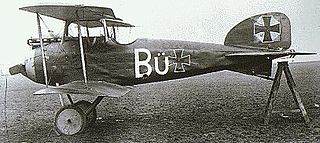
Jasta 2 was one of the best-known German Luftstreitkräfte Squadrons in World War I. Its first commanding officer was the great aerial tactician Oswald Boelcke, and it was the incubator of several notable aviation careers.
The Indian Air Force has been undergoing a modernization program to replace and upgrade outdated equipment since the late 1990s to meet modern standards. For that reason, it has started procuring and developing aircraft, weapons, associated technologies, and infrastructures. Some of these programs date back to the late 1980s. The primary focus of current modernization and upgrades is to replace aircraft purchased from the Soviet Union that currently form the backbone of the Air Force.

A flight commander is the leader of a constituent portion of an aerial squadron in aerial operations, often into combat. That constituent portion is known as a flight, and usually contains six or fewer aircraft, with three or four being a common number. The tactical need for commonality in performance characteristics of aircraft usually insures that all aircraft under a flight commander's command and control in air operations are the same or very similar types.

The Sukhoi S-70 Okhotnik-B, also referred to as Hunter-B, is a Russian stealth heavy unmanned combat aerial vehicle (UCAV) being developed by Sukhoi and Russian Aircraft Corporation MiG as a sixth-generation aircraft project. The drone is based on the earlier Mikoyan Skat, designed by MiG, and encompassing some technologies of the fifth-generation Sukhoi Su-57 fighter jet. In the future, it is planned to act under the control of pilots of Su-57 jets, similarly to the USAF Skyborg programme.

Collaborative combat aircraft (CCA), is a US program for unmanned combat air vehicles (UCAVs) and considered broadly equivalent to loyal wingman. CCAs are intended to operate in collaborative teams with the next generation of manned combat aircraft, including sixth-generation fighters and bombers such as the Northrop Grumman B-21 Raider. Unlike the conventional UCAVs, the CCA incorporates artificial intelligence (AI), denoted an "autonomy package", and is capable of surviving on the battlefield. It is still expected to be much lower-cost than a manned aircraft with similar capabilities. The US Air Force plans to spend more than $6 billion on its Collaborative Combat Aircraft (CCA) programs over the next five years (2023 to 2028). The success of the CCA program could lessen the need for additional manned squadrons.
A loyal wingman is a proposed type of unmanned combat air vehicle (UCAV) which incorporates artificial intelligence (AI) and is capable of collaborating with the next generation of manned combat aircraft, including sixth-generation fighters and bombers such as the Northrop Grumman B-21 Raider. Also unlike the conventional UCAV, the loyal wingman is expected to be capable of surviving on the battlefield but to be significantly lower-cost than a manned aircraft with similar capabilities. In the US, the concept is known as the collaborative combat aircraft (CCA).
